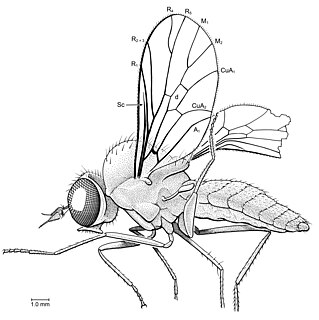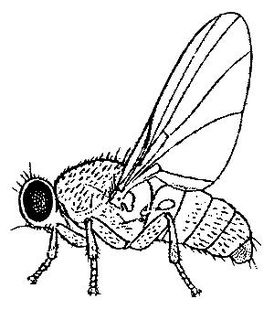
The Bombyliidae are a family of flies. Their common name are bee flies or humbleflies. Adults generally feed on nectar and pollen, some being important pollinators. Larvae generally are parasitoids of other insects.

Calyptratae is a subsection of Schizophora in the insect order Diptera, commonly referred to as the calyptrate muscoids. It consists of those flies which possess a calypter that covers the halteres, among which are some of the most familiar of all flies, such as the house fly.

Cluster flies are flies of the genus Pollenia in the family Polleniidae. Unlike the more familiar blow flies, such as the bluebottle genus Phormia, they are completely harmless to human health because they do not lay eggs in human food. They are parasitic on earthworms; the females lay their eggs near earthworm burrows, and the larvae then feed on the worms. But the biology of this group is relatively poorly known and a few have been recorded from other hosts including caterpillars and bees.

Apsilocephalidae is a family of flies in the superfamily Asiloidea. The family was proposed in 1991 as a close relative of Therevidae distinguishable by genitalic characters. The family contains three extant genera and four extinct genera described from the fossil record..

Atelestidae is a family of flies in the superfamily Empidoidea. The four genera were placed in a separate family in 1983; they were formerly either in Platypezidae or considered incertae sedis. While they are doubtless the most basal of the living Empidoidea, the monophyly of the family is not fully proven. The genus Nemedina seems to represent a most ancient lineage among the entire superfamily, while Meghyperus is probably not monophyletic in its present delimitation, and it is liable to be split up eventually, with some species being placed elsewhere. In 2010, the genus Alavesia, previously only known from Cretaceous fossils, was found alive in Namibia, subsequent species were also described from Brazil.

The fly genus Deuterophlebia is the sole member of the small monogeneric family Deuterophlebiidae or mountain midges. Adults have broad, fan-shaped wings, and males have extremely long antennae which they employ when contesting territories over running water, waiting for females to hatch. Larvae occur in swiftly flowing streams and are easily recognized by their forked antennae and the prolegs on the abdomen.
Apystomyia is a genus of flies in the family Apystomyiidae. The genus contains the single living Apystomyiidae species, Apystomyia elinguis, which is primarily found in California. Details of its life history are largely unknown. The extinct genus Hilarimorphites is known from the Cretaceous Burmese and New Jersey ambers. Formerly placed in the Asiloidea, molecular phylogenetic studies in 2010 placed the genus unambiguously as a sister of the Cyclorrhapha within the clade Eremoneura.
Megabraula is a fly genus in the family Braulidae. These are very unusual flies, wingless and flattened, and barely recognizable as Diptera. Megabraula is found in Nepal and is 3 mm in length. Both species are found in the nests of Apis laboriosa

Australimyzidae is a family of flies (Diptera). There is 1 genus, containing 9 known species known from Australia and New Zealand and subantarctic surrounding islands. They have saprophagous larvae.

Phytomyza horticola is a species of leaf-mining fly in the family Agromyzidae of the order Diptera. For a time it was treated as Chromatomyia horticola, but its original name has been restored after genus Chromatomyia was synonymized with Phytomyza. The species is a pest of high economic importance affecting the vegetable crops in temperate and tropical regions.

Apystomyiidae is a small family of flies containing the living genus Apystomyia and the extinct genera Apystomimus and Hilarimorphites. The single living Apystomyiidae species, Apystomyia elinguis, is native to California. Species of Hilarimorphites have been described from Mid to late Cretaceous Burmese and New Jersey ambers, while the single Apystomima species is from the Late Jurassic of Kazakhstan.

Hydrophorinae is a subfamily of flies in the family Dolichopodidae. According to Germann et al. (2011), the subfamily is polyphyletic.
Thinempis austera is a species of dance flies, in the fly family Empididae.
Thinempis esperance is a species of dance flies, in the fly family Empididae.
Thinempis minuta is a species of dance flies, in the fly family Empididae.
Thinempis takaka is a species of dance flies, in the fly family Empididae.
Thinempis turimetta is a species of dance flies, in the fly family Empididae.

Fergusonina, the sole genus in the family of Fergusoninidae, are gall-forming flies. There are about 40 species in the genus, all of them producing galls on Eucalyptus, Melaleuca, Corymbia, and Metrosideros species in Australia and New Zealand.
Eremoneura is a clade of flies within the Brachycera that includes the Empidoidea and the Cyclorrhapha and is a sister of the Asilomorpha. They are thought to have evolved around the Mesozoic. The group includes fossils described in the genus Chimeromyia from 125 million year old amber which show both empidoid and cyclorrhaphan characters. The monotypic family Apystomyiidae has also been placed within the Eremoneura as a sister of the Cyclorrhapha.

Archisargidae is an extinct family of brachyceran flies known from the Jurassic and Cretaceous periods. It is part of the extinct superfamily Archisargoidea. Most members of the family are known from the Callovian-Oxfordian Daohugou biota of Inner Mongolia, China, and the equivalently aged Karabastau Formation of Kazakhstan. The family has been found to be paraphyletic with respect to Eremochaetidae in a cladistic analysis.











